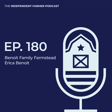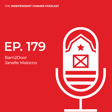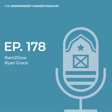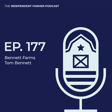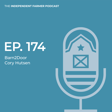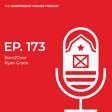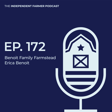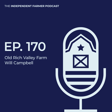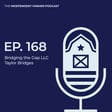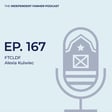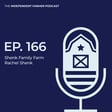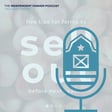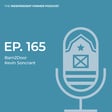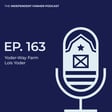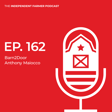Become a Creator today!Start creating today - Share your story with the world!
Start for free
00:00:00
00:00:01

How to Save Hours on Delivery Day with Terra Firma Farm
In this episode of the Direct Farm Podcast, we talk with Brie Cassadei from Terra Firma Farm on the steps she took to streamline her delivery program, and get hours of her time back. Brie walks us through her average delivery day and the tools she uses to make it all easier, and make fewer mistakes in the process. Terra Firma Farm is a community farm dedicated to creating healthy products for both you and the environment, located in North Stonington, Connecticut.
http://terrafirmafarm.com
https://www.barn2door.com/resources
Transcript
Introduction to Direct Farm Podcast
00:00:02
Speaker
Welcome to the Direct Farm podcast, the weekly listen for farm selling direct.
Factors for Farm Success
00:00:07
Speaker
We'll talk about the four levers for farm success, which are quality, brand, price, and convenience. We'll hear from outside industry experts and producers like you to delight your customers, save time, and to increase your direct farm sales and business. We're glad you're here.
Meet the Host and Brie Casade
00:00:26
Speaker
Welcome to the direct farm podcast. I'm Rory, your host for today's episode. We've got a great conversation for you today with a member of our farm advisor network, Brie Casade of Terra Firma Farm Creamery. Welcome Brie. It's great to have you here. It's been a little bit since we've had you on since I think the first time you came on as a farm advisor. So could you maybe start by introducing yourself and your farm and what you produce there?
About Terra Firma Farm Creamery
00:00:50
Speaker
So I'm Bree. I'm the owner and farmer of Terra Forma Farm. We are mixed livestock and dairy operation in Connecticut and we raise Jersey cows are our biggest thing and my favorite thing.
00:01:05
Speaker
and chickens and goats and sheep and ducks and turkeys and all of that stuff for meat and eggs and milk and we have a pretty awesome operation where we have an on-farm creamery so we pasteurize and bottle all of our own fluid milks and yogurt here on the farm so whole milk, coffee milk, chocolate milk, a bunch of flavored milks
00:01:25
Speaker
Easily we do eggnog and then we take all of that stuff and we do home delivery and online direct to consumer and then a couple of farmers markets and a handful of grocery stores. Awesome.
Community Support & Kickstarter
00:01:37
Speaker
Yeah. And I guess you kind of brought up the creamery there, which I feel like is always such a cool thing to talk about, but TerraFirm is very involved in your community and the community was actually a big part of making the creamery happen. Could you maybe talk about that?
00:01:51
Speaker
Sure. So we started out as a educational nonprofit. So I grew up, not a farm kid, but loved being on farms and wanted to give that experience back as family farms started to disappear. If you were in fewer kids had that connection. So farm camp field trips, after school programs and those kinds of things, basically getting our community youth out to the farm, reconnecting them to agriculture. So.
00:02:13
Speaker
bringing them out, collecting eggs, milking cows, moving chickens, doing some gardening, really like true on farming with them. So that was in 2004 that we opened the farm. And then this is our 19th year of doing farm camp. So that's pretty amazing. But then when we decided we wanted to start the Creamery, we did a Kickstarter campaign with our like community members and farm followers and they matched. We had 50 grand that we were putting in to start. It went
00:02:39
Speaker
way beyond that, but we did 50 grand and they matched 50 grand through a Kickstarter. So it was so awesome. Terrafirm was known around town for all that support that we've always had, which is awesome. And so that's when we opened the Creamery. Yeah. Wow. And that's so crazy to think that kids that were going to your farm camp 19 years later, that's just crazy to think about for you too. You saw them when they were little kids. Those are adults now.
00:03:05
Speaker
Yeah. They are graduated from college and they have jobs and are getting married. And I'm like, Oh my gosh. I remember when you were, you know, coming to farm camp. Yeah. That's wild.
Pandemic Shift to Online Sales
00:03:16
Speaker
Well, you chose to sign up with Barnador pretty early last year. What were some of the things going on at the farm that led you to choose Barnador at the time?
00:03:25
Speaker
We always have had a pretty busy farm store and did farmer's market. So we had that direct to consumer, but online sales was never really something that was.
00:03:36
Speaker
done well or easy for either us or the customers. So with the pandemic and with how everything was switching, our idea was to pretty much switch completely to home delivery and some pre-order pickup. So we used a couple of platforms and did just lots of text messaging where customers were sending them in and lots of emails where they were sending in orders. And it was a disaster, but it was growing. So we knew we needed
00:04:05
Speaker
do something. So that's when we found Barnes and Door and it's been for us, I talk about all the time, it's been the most amazing business decision I think I've ever made. It personally makes my life so much easier as a business owner, but financially and like the logistics of everything and even what the customers have, Barnes and Door has been ideal for us. So the pandemic and switching to delivery, home delivery was really the switch to Barnes and Door.
00:04:32
Speaker
Yeah. And so you guys weren't doing any delivery before a few years ago? Right. We weren't doing any delivery before the pandemic. Yeah. So when the pandemic hit, which was a couple of years ago in March, we started very small home delivery. It was like a joke to think of it compared to now. So it was like one day a week, but it was maybe the first month we might've had
00:04:56
Speaker
I don't know, maybe 80 home deliveries the whole month or something silly like that. And it was like, I could personally do them with my son. When he came home from school, we would load up the minivan and run all of our deliveries. It was like a couple of hours and they were all sent in via like emails, but then it just started growing. And I was like, wow, people really like this. And you know, now we're doing 80 a day. So it's just, it's a completely different story. Wow.
00:05:22
Speaker
It's not every day that we do 80, I shouldn't say that, but it could be. It has to be streamlined. There was one day it was our fault, but it was one day we couldn't get into our post sheets. And I felt like my world was crumbling. I was like, I couldn't even, I didn't know what I was going to do. The drivers were here.
Operational Efficiency with Barnador
00:05:39
Speaker
We were like getting ready to start the day. And I was like, how are we going to get these orders if we have to go through emails and go back to how it used to be? I was in like a full on panic.
00:05:46
Speaker
Thank God, you guys are so amazing. And in seconds we were like back up and my sheets were printed, but it has to go so smoothly because of how things are now. So it has to go easy for the customer. It has to go easy for us to like figure out the inventory we need for the day. It has to go easy for us to have their invoices and our pick sheets. And then we use the delivery routing service route. That has to be like a streamline. And so.
00:06:15
Speaker
my day to get the ball rolling on the delivery part of the day is so easy because it's all through barnage door. It's a couple of clicks here and a couple of clicks there and it's all ready to go. That's so awesome to hear. And definitely you keep scaling and then you get to a point where if the things that you've put in place to streamline everything, if that has a hiccup, then that's a big problem. You can't really just go back to the way you used to. So I'm glad support was able to help you out with that.
00:06:41
Speaker
No, they were awesome. I was too, because I was like full on panic. What are we going to do right now? And of course, like Wednesdays are our busiest day. So of course it happens. Oh no. Well, kind of going back a little bit, what was kind of your initial setup? Like how was it transitioning over to Barnadore from what you were doing? And maybe even for your customers too, how did they translate? Yeah.
00:07:04
Speaker
For me, it was amazing. So when we finally signed on to Barnes-D'Or, we were given an onboarding member and he went through all of our inventory with me and what we wanted to be on our store. So we loaded our store first because we were already in motion and we had a website already up that was fine for the time being.
00:07:26
Speaker
So we decided, let's go straight in. Let's get the store rolling. And we'll work with the other stuff after, which everybody at Barnes-D'Or did what they've done. So that was awesome. But our onboarding member helped us. He loaded all of our inventory for us. He helped me with pictures and categories. And I feel like I'm very proficient with Barnes-D'Or now. But in the beginning, it was all new. Anytime you give me software, it's new. So they held my hand through everything. He helped.
00:07:55
Speaker
loading everything and it was fast. Our store was up and running within, I would say, two weeks max. And we have almost, I think, 600 inventory items. That's crazy. So he loaded them all in all of our categories. We work with about 15 other vendors as well at this point. So it's not just terra firma items, it was all the other things that we sell as well. So he got those all up and tagged with the correct vendors and items and categories and
00:08:22
Speaker
This store, like I said, it's pretty awesome. It's all up and running. So our account manager at that point was on and she was amazing. So she helped with MailChimp, which was how we communicate with all of our customers. So all of our emails that we've selected over the years got put into one MailChimp account.
00:08:40
Speaker
And then all the marketing and website people at Barnes-door made, you know, these great templates and our emails that go out every week. Yeah. I feel like from the beginning, Barnes-door has held my hand and every step of the way. It's like all of a sudden, I think I said this in the last podcast, it was like.
00:08:58
Speaker
As like a single entrepreneur person running so many different things, I felt like I hired this giant team that came in and helped with every single thing. So they helped with customers, they helped with marketing, they helped with the website, they helped with the store. And it was amazing to me. And even still, we have a new advisor and we still meet every other week and go, he bounces back ideas. And even last week he was like giving me ideas that I just haven't thought of. And so it's.
00:09:24
Speaker
I feel like that's the best part of Barns Door is the continual support with whatever problem I have. That's awesome to hear. Yeah, definitely.
Delivery Optimization with Rautific
00:09:33
Speaker
It's a team effort too. You know, everybody's jumping in and helping out where they can, which is really cool that you got to really be a part of that and experience it from all those different angles.
00:09:42
Speaker
Yeah. Yeah. It's awesome. There's so many of you. And even now, when I have a problem, like I'll send it, you know, to my advisor and then he'll tag the right people and they get back within, you know, it's never been longer than an hour. That's impressive. Well, then also from the customer perspective, that can be a big switch up for people that might've been ordering from a farm for a long time. And they're used to maybe calling the farmer or just texting them. And then.
00:10:09
Speaker
You kind of have to get all these people transitioned and used to ordering online because obviously that's a big point is you want to save yourself that time. So you're not having to respond to those texts or emails. And so how did that transition go for your customers and how do they kind of respond to the new store?
00:10:23
Speaker
So they thought it was great because it was a total mess before. So obviously they were just texting or emailing or calling in an order. So to them, it's only one person, but to me it was everyone doing that. They loved the switch. They thought the store was great. You know, once they set up their account, which was easy for them and they got everything in, you know, they put their zip code in and then it automatically remembers their, their.
00:10:47
Speaker
require their requested delivery route or pickup it automatically saves their credit cards. A lot of them do subscriptions. So that was awesome. But I think the other thing that they reported back was some of them were calling me and asking me questions, but most of them were using the online chat direct with Barnes door. So
00:11:07
Speaker
to door, their expertise was the store. So they were handling the questions. They were walking customers through signing up and we have young customers and we have older customers who aren't really good with the computer and they were walking them through every step of the way.
00:11:22
Speaker
So that was awesome. So for the customer side, they loved it because they too felt like they had customer support. And it's to them, it's set up really well. It's very user friendly. The customer side of Barnes & Door stores. So they like that. They can find the products that they need, they can search for things. The pay in the checkout is super easy. Of course, people, you know, stumble here and there, but for the most part, all of our customers are thrilled with how easy and convenient and intuitive the store is now.
00:11:51
Speaker
That's great to hear. Cause I know, yeah, that can definitely be a transition for people. And especially when maybe they have a personal relationship with you and they're like, Oh, I like just being able to call Brie, but obviously that, that still has taken a lot of your time. So you want to kind of help through that transition. Well, it's been a little while now that you've been on the farm advisor network. And so I was curious, what has your experience been in that role and maybe what have been some of your highlights from it?
00:12:14
Speaker
So that's been like a super fun bonus for me. That's the other side of everything. So it's been awesome to meet other people all across America that are also using Garden to Door. So I'm
Learning From Other Farmers
00:12:27
Speaker
this tiny little farm in Connecticut, but one of the people that I talk to often is out in
00:12:32
Speaker
Seattle or is out in Colorado. Some of us are vegetable farmers. Some of us are protein farmers. Some of us are dairy farmers. So we all talk about things that have worked for us, but we're also all farmers transitioning to direct to consumers. So we found ideas back and forth. We help things that I stumble upon that I'm like, you know what? This might be able to be run better. We talk about those things. And then we talk to all of you guys as well, your staff.
00:13:00
Speaker
And it's awesome just to have like that other side of camaraderie, but also I've made many mistakes in life and you don't want somebody else to learn by making the same mistake. So it's great. And then on the flip side, also we talk about things that work great. So some of my best ideas have come from other members of, you know, the fan network. They're like, Hey, at farmer's markets, this works great for us.
00:13:23
Speaker
And then we replicate that and it does it works great you know so that's been awesome just to have this group of people all transitioning and learning the same time.
00:13:32
Speaker
Yeah, it's really cool. You mentioned there the mistakes thing. I feel like that's something I get to work with a lot of these farm advisors. And I feel like that's the thing I hear over and over again is everybody's saying, I've made a lot of mistakes. So if I can at least help people avoid those, then it will be a success, which is great. And it's a, it's an awesome way to kind of look at it. And I think it's really cool that we, you guys have all kind of been able to participate with barn to door and share that knowledge that you have.
00:14:00
Speaker
For me, I say it all the time to anyone who asks, it's not a joke, and as a business owner, going with Barn to Door has been the best business decision I've ever made. And so to help another farmer understand that, because I do understand how precious our time is and how limited it is, not only as a farmer, but as any entrepreneur or business owner. So switching to Barn to Door, the amount of time it's saved and the amount of things it's done for me,
00:14:27
Speaker
The band network is awesome because like we just did a connect a little while ago and like you get to talk to someone who's considering it. And that's where I can be like, you know what, this worked and this worked and this is how much our sales is. So it's awesome to be able to like, you know, when you buy something or invest in something, you want like real stories. So that's awesome to help answer questions to the new people who are just considering going to barn.org.
00:14:50
Speaker
And it's cool too. I mean, all of this is new to a lot of farmers. And so it's really cool. Just, I think the last connect session that you were hosting, another farm advisor came into the session to ask you questions about how you've gone about doing delivery.
Integrated Farm Management Tools
00:15:05
Speaker
And it's cool. It's like, this is another member of a team of.
00:15:07
Speaker
I guess quote unquote the pros but there's still a lot of unknowns at play there and so being able to have that space to ask you who somebody who's really proficient and does a lot of deliveries every day to be able to pick your brain about how you set it up is pretty cool. That kind of actually segues really nicely because this episode we're going to be kind of diving into your favorite feature on Barnadore and there's a lot of different integrations that Barnadore offers with other softwares and so we can't always refer to those as like tools in the tool belt.
00:15:35
Speaker
Obviously with the hope of saving you time, like you've kind of been mentioning. And so there's, there's MailChimp, like we've talked about, there's QuickBooks for money management. And you've been using the platform for over a year now and have had a lot of success growing your business in that time. So what is your favorite integration and what is the thing that kind of helps Terraform a farm save time and increase your sales?
00:15:57
Speaker
Sure. So I hate to say that it's my favorite because definitely some other favorites that I have, they all have like their own thing, but I, in all honesty, like the one that we rely on the most and the one that I use the most is the route. And funny enough, like we started using another one of those like suggested deliveries in the beginning.
00:16:19
Speaker
Um, and we ended up switching over to Rotific and it, that to me is amazing. The amount of time and like even saves us money now with gas. Um, and we were at the point where we hire delivery drivers. So making sure that they're being efficient. Rotific is who does all of that for me. I literally click like six buttons, I think in the morning with a mouse and, uh, it does the rest.
00:16:44
Speaker
Yeah. And I guess maybe to go backwards a little bit because, you know, route optimization is, uh, is super useful tool, but maybe for a farmer that was, that's just starting out, like, what was your starting out with delivery? What did that initial process look like? And how many days a week were you doing? What products were you doing with delivery? Could you maybe talk about that?
00:17:04
Speaker
Sure. When we first started, it's actually funny now that we're thinking about this. So when we first started, I used to have to. On my phone individually, put the addresses in that we were going to in a day. And then we were using, I think either Google maps probably or Apple maps. And then with my finger, I would have to like. Yes, kind of, and like drag them and move them so that it looked like it was going to be a good route.
00:17:30
Speaker
but then you could only do 10 at a time so then you would have to like mix like the second one as we got a little bit bigger but it's funny because there were definitely days where we had less than 10 because I knew we didn't need to do another one so it's funny to even think about that but that was like a total waste of time I mean it would take forever and then it never was right because it was me like guessing well that looks like a good move um
00:17:53
Speaker
So, yeah, so then from there, I think we switched to another service that you got online that again you punched them all in and then it did the best for you, but even that wasn't that great.
00:18:06
Speaker
So then now it's all integrated, obviously. So it's definitely efficient, but in the beginning it was just our own stuff. So it was just milk, meat and eggs and things that we produced. And then very quickly, I realized that since we were charging delivery fee, the more items I started adding, we had retention of customers and they were like ordering.
00:18:27
Speaker
more consistently every week so yeah it's great to be able to get your milk and your eggs and your yogurt and your meat but when you can also get like local bread and local coffee then all of a sudden we had even more people coming and then we added in vegetables and we added in some other meat we didn't have and
00:18:45
Speaker
jams and coffees and chocolates and seltzer I mean the list is crazy but then I started seeing like hey we make this like a mobile farmers market and then people can actually use us as they're like one stop grocery store shopping that was when
00:19:02
Speaker
We now consistently have customers who every single week order from us and it's a big list of stuff. They get everything you would normally get at a grocery store or at a farmer's market and it's all coming, you know, one stop shop. So that I think was the biggest like transition from the beginning. In the beginning, we probably had, I would say 10 items on our list of what they could get. And now we have close to 607.
00:19:25
Speaker
Well, that's awesome. Well, and we've talked a little bit about the growth that you've experienced and obviously just with the inventory
Managing Delivery Growth
00:19:32
Speaker
there. And then you, as you mentioned earlier, you used to be able to fit all your deliveries in that, that 10 stop allowance that Google maps had. And now obviously you're doing around 80 almost a day. Cause you'd maybe talk about how have you kind of managed the growth there and what has that been like?
00:19:47
Speaker
Yeah, so there's a lot of changes that have happened. We deliver basically a handful of zip codes every day now, opposed to just offering delivery for a radius around where you're going. Ours is, okay, we're going to do these five zip codes every single Monday. We're going to do these five zip codes every single Tuesday, and it stays that way.
00:20:09
Speaker
It's great for us because now inventory is such an issue. We need to know what we have to have and how big the orders are going to be. It's a daily thing in that sense. And also, when you're sending out your drivers, they're on a smaller route now. It's pretty consolidated. And their stops are closer together. So for us, that's great. And then on the customer side, they like to know that their delivery day is every Tuesday. It's not going to change. And now they have to order 11 PM the night before for delivery the next day.
00:20:38
Speaker
That to me, if you were to ask me, like the advice I would give her farmer or starting that out, train your customers to not be that close. Cause I can't change it now at this point because they have learned that's just what they're used to. But I wish we had a little bit more time. So that would be something that I would suggest not doing. And then our deliveries, we don't have a limit or.
00:21:02
Speaker
like a minimum or a maximum, they can order whatever they want, but we have one delivery fee. So no matter how much you order, it's just a $5 delivery fee that actually, it went up a dollar. I think we started at four and so that really hasn't changed that.
00:21:15
Speaker
Yeah. Awesome. Well, and then I guess for anyone listening that is maybe thinking about doing delivery, that was a great piece of advice you shared there already about making sure you give yourself a little bit of a buffer on timing to get orders prepared, but walk us through your delivery day. What does that look like when everything goes right? What does that look like? Yeah.
00:21:33
Speaker
So at this point, so our orders for the day close at 11 p.m. the night before. At that point, hopefully on a given day, I am sound asleep at 11 p.m. So it's awesome. It just goes on its own. And then when we get up, we do a packet and pick list from bar on door. So we log into our account and then you can pick your pick and pack list. You can pick by the day and you can also pick by the vendor. So we do both. So say it's Tuesday, right? So I log in and we print out
00:22:02
Speaker
you know, two clicks, you print out every single invoice that's going out for Tuesdays and the said invoice has the customer's name, the customer's email, their phone number, any notes that the customer puts in is on there, and then every item that they ordered is on there. So we get all of those. And then we also do it by vendor poll sheets.
00:22:20
Speaker
So this prints out exactly how many half gallons of whole milk we need and exactly how many just for the given day. So exactly how many packs of ground beef we need and how many one pound pints of honey we need. So it gives us an itemized pull sheet. We can do it by vendor or you can do it by the day. We do it by both just because that's what works best for us. So then you can check, okay, we have everything we need to go out for this delivery
00:22:44
Speaker
day and we use those vendor sheets in ordering so I can call my vendor and say hey for today we need this that and the other so we do both of those but all of that we're talking like I've invested maybe four minutes by now and so we're maybe at like you know 504 am at this point that's all printed out and then there's an actual integration and it just sends it right along
00:23:10
Speaker
Then I do log into Rotific at this point and you set how many drivers you have for the day. And for us, that's based on how many stops are going to be going on. Or we also learned around the holidays when we have big orders and eggnog is one of our big things. We actually had to split it by what was going to fit in our delivery van.
00:23:30
Speaker
Wow. Yeah. So that was a learning thing, but that's what's great is. So I already know what's going out for the day. I already know how many, um, stops we have total. So I've learned to be like, okay, this is going to be two drivers today. And then you go into route civic and you put your drivers in and it already has all your stops. And so you hit optimize and then.
00:23:53
Speaker
It doesn't, and then it gives you a numbered stop list. And then we just take all of the invoices from the morning and we take that numbered stop list and magic marker. You know, John Smith is number seven on route number two. And then, so we just put them that way. And then when the drivers come, I hand them their invoices and their pull sheets and then they go. And honestly, maybe 5.30 AM right now. Wow. So.
00:24:19
Speaker
The whole entire day can get organized within under 30 minutes. And that's great. And then with that packing pull list, you pull, you can pull fast. So you can go into your walk-in and you can pull crates of milk and crates of yogurt. You're not pulling individual orders. And then all that goes into the respective vans and the route typically lets you set how many minutes you think each stop is going to take.
00:24:43
Speaker
So we give our drivers five minutes at each stop. It never takes that long. But we give them five minutes at each stop to pull their orders, put them into their milk crates or their coolers. And then the notifications from Rautific are all automated now too. So I get a notification that the driver has done that stop. The driver gets their checklist is checked off. And then the customer also gets a notification that their delivery has been made. So that's all automated too.
00:25:13
Speaker
Wow. That's awesome. I'm curious that you mentioned that like, especially just that whole getting organized part was like 30 minutes. How long did all that, did that whole process take you before you were using route? There were days when the truck wouldn't leave until two, three o'clock in the afternoon, like trying to figure out, okay, this was here. And we had to take the orders every day when they were coming in, if they were coming in via email or text.
00:25:39
Speaker
I would have to print them out and on the top, we had like file folders, like these are Monday, this dip code, this is Tuesday, this dip code. And we would hope that I got them all. So everyone loves chocolate milk. And so we give out for mistakes and apologies. Like in the beginning, we would give out so many kinds of chocolate milk and so many half gallons. And I would write like, I'm so sorry, we messed up your order. So chocolate milk and eggs. And then we sell a local chocolate. And so.
00:26:09
Speaker
Those are like my like bribery, I'm sorry, things that I give customers because we were messing up like all the time. And to be honest, like we rarely do that anymore. Like we do. We still make plenty of mistakes. Don't get me wrong. But compared to the beginning when I was like, I hope we got all these orders. I hope we got this one. I hope that was their complete order. There was a lot of mistakes and now it's all just, it's all right there and done.
00:26:32
Speaker
Yeah. And I know you've talked to us a little bit before about just the fuel savings, but especially right now with how expensive fuel is, what does the impact been there having that route optimization?
00:26:43
Speaker
Oh my gosh, that's crazy. So everybody, I mean, gas is just a joke at this point. And you know, we did just sit down and say, we have to go up in our delivery fee or add a temporary fuel surcharge. We right now today are trying to figure that out. We've never before charged wholesale accounts, but it's now the norm to charge wholesale accounts of delivery fee because.
00:27:02
Speaker
Gas is crazy. And diesel is just even more crazy. We charge the $5 no matter what it is. When we switched to Rautific, we saw huge savings in fuel because it makes the most efficient route it possibly can. And if it's intuitive, it knows which way to do it based on the map. And so we were seeing huge savings in gas because of that, but we were also seeing
00:27:28
Speaker
I was seeing savings in the time that our drivers were going out because the route was more efficient. So they were definitely gone for less of. Less time. And in the beginning, you know, it was just my father who was volunteering to do it and myself. And so it wasn't really an expense, but now that we hire people, we've been able to save some of that cost by using relativity.
00:27:51
Speaker
Yeah, that's great. And I know that's a lot of times can be the use of that delivery fee too. It's just to pay the drivers, cover the vehicle. And so that's really nice too. And so we've talked a little bit about how you have things organized now, but are you doing delivery every single day and you touched on the delivery fee?
Enhancing Customer Experience
00:28:06
Speaker
How did you decide on that?
00:28:08
Speaker
So right now we are doing deliveries six days a week and then on day seven, that's one of our biggest farmer's market days, so we try not to do anything. But yeah, so six days a week and it's based on zip codes. And so we basically just added a day as we got too big for the day before. It just makes sense to have certain zip codes each day so that the drivers are not driving some from one side of Connecticut to the other side of Southeastern Connecticut.
00:28:35
Speaker
And yeah, so we basically have six kind of clusters we call them that we cover for customer base. We started talking about the delivery fee there. I think that's always a big decision, I guess, for farms is one, if they're going to charge a delivery fee or not, and then also how much to charge because that's been unknown for everybody. So how did you decide on your delivery fee? And what, why would you maybe encourage other farmers to make sure that they're at least charging something?
00:29:01
Speaker
There should be no reason why you don't charge a delivery fee and your customers are going to complain, but you have to look at it at the sense. So first of all, look at places like Walmart or local chain grocery stores. So stop and shop, right? Or ones that are around here.
00:29:16
Speaker
Their delivery fees are like 15 bucks and they have way more money than probably all of us farmers put together. So the fact that they're charging that much means that it has to cover an expense. For us when we started getting bigger we bought refrigerator vans and so we met with like farm service agency and we went over that. The cost of delivering should cover some portion of this new vehicle that we're buying specifically for this.
00:29:42
Speaker
So how many deliveries, do you have to make to cover the cost of that man and how much is that going to cost and realistically how many are you going to get in the first year, so you really do have to sit down pen and paper. and figure out what it's going to be and then it has to be a number that you feel comfortable with I honestly do not feel $5 is enough but.
00:30:00
Speaker
On the other side, we are trying to market, right now we're doing like a marketing campaign to get more customers in our zip codes and our stops that we're already going so that we can keep it at $5. So if you have enough stops that are close enough together, then that $5 is going to cover a little bit of your vehicle expense. It's going to cover your cost of your driver, hopefully, and it's going to cover the fuel.
00:30:26
Speaker
If you have enough stops that are close enough together on a given day, then $5 is okay. But if you're driving, you know, from one stop and then really far away to the next stop, it has to be more than $5 because it still has to cover those same costs. So you do have to sit down and figure it out, but under no circumstances should you be delivering for free. That to me is not something that should be even considered.
00:30:49
Speaker
You're offering your customers a great privilege in a way. Yes, it's great for us as farmers and business owners, but it's also great for customers. I know I would appreciate it if I was not raising my own food to get it delivered to my door. So you have to look at it in that sense. And also, yeah, gas is crazy expensive and it's going up for me to go to the grocery store. I got to fill my own car and then I got to take time out of my own day. So how much does that cost? You should never undersell yourself. We're all valuable people and you got to cover that in some way.
00:31:19
Speaker
So I think the delivery fee, it really does have to cover those, you know, few expenses that it costs to get the product to people. I'm curious, what was the point that you decided to bring on delivery drivers? Cause I think that's like leveling up, I guess your delivery program is the point where you're like, okay, I need to hand this off to somebody else so I can still actually get something done during the day at the farm. Do you remember like about when that happened in your growth periods?
00:31:45
Speaker
Yeah, so it was actually really early because it was one of those things where I was like, you know what, for me to pay somebody to do these deliveries is way more better use of time and money than it is for me to be out doing it. When you get beyond, I would say an hour's worth of time. It just really isn't the best use of time. If I'm the person who's writing the marketing email and it takes that time,
00:32:09
Speaker
I can be, you know, doing marketing or I can be, I don't know, doing other things while your said delivery driver is out doing it. And there's, you know, delivery drivers, they have to have their license and they have to be safe and they have to be pleasant for your customers because they're now representing you. So you have to factor that all in. But I think if you can find the right people to do your delivery route, it's definitely money well spent for the time that it frees up.
00:32:35
Speaker
Yeah, definitely. I think something else that kind of comes with that is farmers like that personal interaction. But when you sell a product online and deliver it to someone's doorstep, there's a possibility that you never even see that person. So I'm curious, how does Terra Firma Farms still kind of provide a personalized and unique customer experience through that process?
00:32:57
Speaker
That's so important. And so one of the other things that I think important to hit on there is if you're just starting out as a new farm, that's even harder because it's even more important. We're very lucky we've been open now for 2004 and people
00:33:13
Speaker
know who we are and we have a great brand so they see that, and they you know they know the name Tara firm at this point but if you're like all the sudden just popping up online. You're like you said there's no connection there so you do still have to somehow have a connection and I think.
00:33:28
Speaker
For us, so MailChimp emails, those are huge. We send those out a couple of times a week. That's me talking to my customers and that's a personal email that is talking about what's up at the farm and what's new products and we try to give recipes every week.
00:33:46
Speaker
And so it's huge to have that communication with your customers for sure still. So for us right now, it's our MailChimp newsletters and emails. Social media is great, obviously. All day long, I'm trying to snap pictures of calves or whatever's going on at the farm because that's, you know, you don't realize it, but that's communicating with your customers. They're seeing what's going on. So that's huge.
00:34:07
Speaker
And then we do use, we pay a little bit extra, but we do use the customer notification through RouteTific. And we didn't in the beginning because I was actually the person that was doing the delivery. So we used a text message, the customer directly from my phone, pay your terraformal orders here. And they would text back, hey, thanks, blah, blah, blah. Now it's set up. So it's an automatic notification from RouteTific that goes to the customer. But the message actually has my cell phone number in it.
00:34:37
Speaker
So, because there's a bunch of drivers going out this way, the customer, it says, thanks for using terra firma, your milkman has just delivered your order. If you have any questions or concerns, or if there's anything wrong with your order, please text free. And then this way I get all that customer communication and I can then call the driver and be like, Hey, you forgot a gallon of milk at this stop. You have it in the van.
00:35:00
Speaker
for whatever the issue is, but so that's actually been huge because you still need that. It's not face to face, but you still need that direct communication with your customers because they need to still feel personally connected to who they're buying all of their stuff from. And even just for me, it's a great way to still stay in touch with them. A lot of them will text back, you know,
00:35:22
Speaker
There isn't an issue with their order, but a lot of them text me every single week when they get their order and tell me, Oh my God, the bagels are so good this week or even silly stuff, but it's still communicating with our customers for sure.
00:35:35
Speaker
Well, you mentioned earlier that you're starting to try and hone in on some of these areas that you're already delivering to and just make them more dense for your delivery drivers. So you can be doing more deliveries in areas you're already delivering to. How have you kind of gone about advertising that or how have you ever advertised your delivery program to try and to grow it?
00:35:55
Speaker
So we've actually, luckily enough, been pretty much word to mouth up until now with boosted Facebook ads or something like that. We never did a big marketing thing. So this year, our goal has been to actually invest the money in marketing. We branded with an amazing artist and graphics designer a couple of years ago, and that was huge. So.
00:36:16
Speaker
We have one logo. We have one font. It is on every single product, the terra firma. It's on our website. It is. It's that green cow head and everybody knows it. And so that was really big, but this is the first year that we've actually done. I don't know what you call it, but like paper marketing or whatever. So we did postcards. We did, or we're doing postcards and we did like street signs, like the little front yard signs. And we're trying to figure out like a referral or customer reward program or something like that, because.
Marketing Strategies and Customer Engagement
00:36:47
Speaker
It's gotten to the point now where the trucks are out so much and there's enough stops and we're going to enough zip codes. But when I look at the route, I'm like, man, there is like 27 houses on this road and we're doing one. Like, so, and it also got to, it was funny enough because a couple of weeks ago I was doing a delivery and I pulled into one of the customers and I put their order on the thing and I ran back and the guy next door came out and he's like, Hey, I see you guys here every week. What are you doing? And I was like.
00:37:14
Speaker
How does he not know what we're doing? We're literally walking milk to a milk box that has our logo on it. Like, how do you not know what we're doing? And then I was like, he literally has no clue. And so I told him and he was like, wait, what? He's like terraforma delivers. And I was like, yep, we deliver. So the idea was that put flyers in and we picked streets that seemed to have a lot of houses or roots that needed more stops.
00:37:38
Speaker
And now you can do tons of marketing online so you can get certain zip codes. You can get certain addresses right from the post office, which is awesome. And the shipping, the mailing isn't that expensive. So we made up great postcards. We made a promo code and we put like the QR code for MailChimp on the postcards. You get free milk when you sign up, obviously your first week.
00:37:58
Speaker
And then we just put a cute picture on the front of all of the products that we have. And we're just sending them out and we're just trying to see if we can build up who our customers are. And so far it's been good. And then also it is farmer's market season. So we use the QR code and we made business cards and my farmer's market kids just have to hand them out. That's all I want them to do.
00:38:18
Speaker
Everyone who walks by this table hand them this QR code and it says win free milk. And so every week from every market, we pick one new email and they get half a gallon, about five bucks for us, but it's been unreal, the amount of emails that we're getting. And so that's all those people. And then all those people, when they sign up, farm to door and MailChimp are awesome because it's integrated now that all new email that we add in,
00:38:45
Speaker
get, they go through like the customer journey, like the start, like, welcome to terra firma. And it links them to the store. And it has a video of how you order from our site. And then they get another one a couple of days later that has a promo code. And then they get another one a couple of days later that talks about subscriptions.
00:39:02
Speaker
So all of a sudden, like everything's coming together into one thing where I feel like we're slowly going to start to get new customers. So we've had, you know, this awesome base of customers and word of mouth, but now we're getting new customers and that's, that's the goal.
00:39:16
Speaker
That is so cool. You just brought up like so many great things there that are like marketing wise are so awesome that you're implementing and I'm really excited to hear how they work out. Well, that's really cool to hear how you, how you've been advertising that and focusing on growing it and making those areas that you're already delivering to more dense is, I think that's a really key idea too, that you don't need to necessarily always be adding more zip codes, but just making sure that the ones you're doing are as, as worthwhile as possible is really great.
00:39:44
Speaker
Yeah. I mean, one of the main reasons that I started thinking about it was not only like getting more customers, but saving money for us. I didn't want to go up on the delivery fee because I was going to get resistance from customers if I went up on delivery fee. And so I was like, how can I keep the same delivery fee? But
00:40:00
Speaker
make it so we're getting more. And the only way would be like, all right, I'm going to deliver to you and your neighbor. And maybe I don't have to move the van. Yeah, definitely. Okay. Final question, I guess would just be for a farmer that is just starting with delivery, what would be maybe your two pieces of advice for somebody just starting out and offering a delivery fulfillment and like considering Rautific? What would be your two pieces of advice there?
00:40:25
Speaker
Yeah, my piece of advice, honestly, and people, we get it a couple of times from just local farmers or people who know me. And it's honestly, my answer is do it. Don't hesitate to do it. You can always decide to not do it if it doesn't work out for you personally. But if you don't try it, you won't know. One of the things that we say is milk on every doorstep. And it's true. I think that
00:40:47
Speaker
If we make it the norm for people to be buying from farms and getting it on their doorstep, then it's going to be used more. So if more of us are doing it, then it makes it the norm. And people, not for nothing, as much as I dislike places like Amazon and Walmart, they've trained us to get stuck to our doors. And so customers are used to that. But that's the way of the future. Then we should all jump on that wagon and make it work for us. And I think
00:41:15
Speaker
as a farmer most of us are you know we're small most of us don't have a ton of staff most of us have zero time and i think switching to barns door and switching direct to consumer and using the integration like ratific it's worth every cent that you're going to invest and it's worth my time in the beginning
00:41:35
Speaker
that you invest, that is, you know, a hundred fold back. So it makes your day so much easier. It's going to increase your revenue on your farm. Me personally, it was one of those things that also where we can do things that I always dreamed of doing, but couldn't because we were at, you know, that size, but with growth, you can do more stuff.
00:41:57
Speaker
So we offer new products that we never had. And you know, I can have more cows, which makes me happy. We're farming for a reason. We love, I love feeding people. I love making milk. I love having cows. I love connecting with other people who, you know, want to buy local food. And so your business has to grow to let you do that. And your day has to go smoothly. One of the things my dad always says is you want to get to the point where your business doesn't run you anymore. You run your business.
00:42:24
Speaker
And I think male chimp and barn to door and relatively that done that for me, like having everything go smoothly. All of a sudden it feels like I'm, you know, running it. It's not running me. And so that's awesome. So I would say do it. You'll be so surprised and it's not going to work for everybody, but you're not going to know unless you really try it. You may hate.
00:42:43
Speaker
delivery and that's fine and you may have an area where it just doesn't work for you but i think unless you try it you you're not going to realize you know what amazing growth you can have by going that way i think it's just it seems to be how everything's going people want convenience they want to order online and they still want to stay connected to their farm so i think it's a win-win for all
00:43:05
Speaker
Yeah. Wow. That's awesome. Bri, you've shared a lot of really great stuff today. I'm super excited for everybody to hear. This is really good advice, great tips, tactics. This has been super fun. I want to extend my thanks to Bri for joining us on this week's podcast episode. Here at Barned Door, we're humbled to support thousands of farms across the country, including farmers like Bri, who implement sustainable agricultural practices and support their local community.
00:43:30
Speaker
If you would like to ask Bre any questions directly, you can meet her and other farm advisors in Barn to Door Connect. To learn more and register to attend, go to barn2door.com slash connect. Those sessions occur weekly. For more information on Terra Firma Farm, you can visit terra firmafarm.org. And to learn more about Barn to Door, including access to numerous free resources and best practices for your farm, go to barn2door.com slash resources. Thank you for tuning in and we'll see you next week.
00:44:00
Speaker
Thank you for listening to this episode of the Direct Farm podcast. You can subscribe anywhere you listen to podcasts to automatically download new episodes. For more free resources that you can read, watch, and listen to, visit farntador.com slash resources. Thank you again for tuning in and we'll see you again next week.
